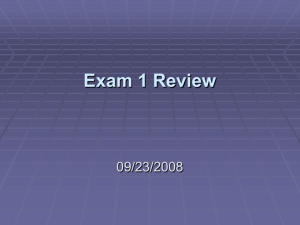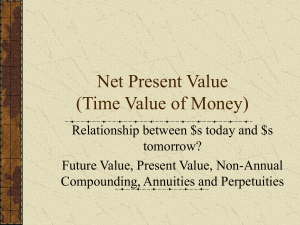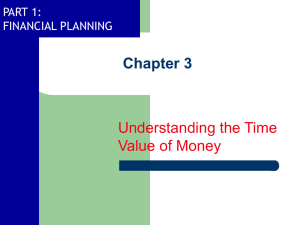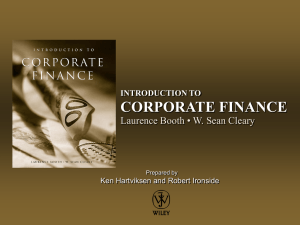The Time Value of Money
advertisement
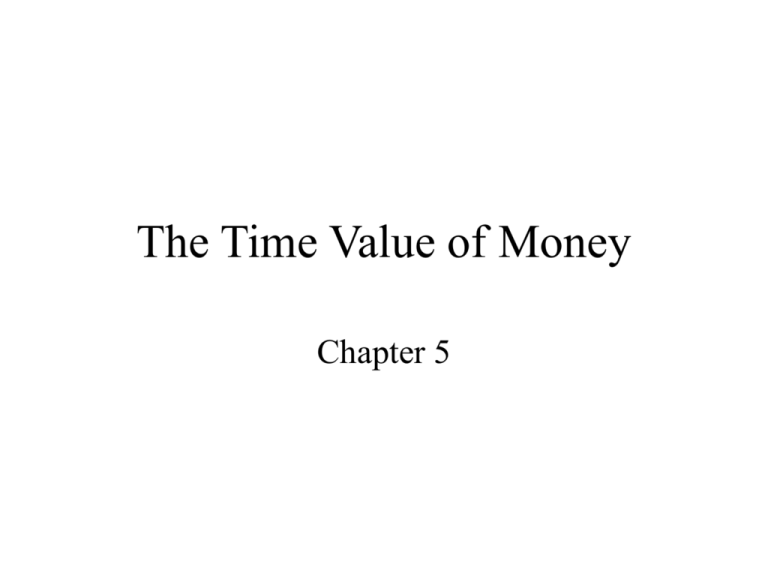
The Time Value of Money Chapter 5 LEARNING OBJECTIVES • 1. Explain the mechanics of compounding when • • • • invested. 2. Present value and future value. 3. Ordinary annuity and its future value. 4. An ordinary annuity and an annuity due. 5. Non-annual future or present value of a sum . • 6. Determine the present value of a perpetuity. Power of time of value of money • History of Interest Rates $1000 ( 1 + .08)400 = ? Power of time value of money • Money Angles: by Andrew Tobias. 1. Chessboard with the King 2. Manhattan Terms • • • • • • • • Compound Interest Future value and Present Value Annuities Annuities Due Amortized Loans Compound Interest with Non-annual Periods Present Value of an Uneven Stream· Perpetuities COMPOUND INTEREST • FV1=PV (1+i) (5-1) • Where FV1=the future value of the investment at the end of one year • i=the annual interest (or discount) rate • PV=the present value, or original amount invested at the beginning of the first year Future value 1.Simple compounding 2.Complex compounding k mn FV PV (1 ) m Future value i n FV 100(1 ) t • • • • FV1=PV (1+i) =$100(1+0.06) =$100(1.06) =$106 Compound twice a year 0.06 2 FV 100(1 ) 106.09 2 Compound four times a year 0.06 4 FV 100(1 ) 106.14 4 Compound 12 times a year 0.06 12 FV 100(1 ) 106.17 12 Compound 360 times a year 0.06 360 FV 100(1 ) 106.18 360 Continuous compounding 100 e n ( 0.061) 106.1836 Illustration of Compound Interest Calculations Year Beginning Value Interest Earned Ending Value 1 $100.00 $6.00 $106.00 2 106.00 6.36 112.36 3 112.36 6.74 119.10 4 119.10 7.15 126.25 5 126.25 7.57 133.82 6 133.82 8.03 141.85 7 141.85 8.51 150.36 8 150.36 9.02 159.38 9 159.38 9.57 168.95 10 168.95 10.13 179.08 0.08 1 K eff (1 ) 1 1 1 (1 0.08) 1 1.08 1 8% 0.08 2 K eff (1 ) 1 2 2 (1 0.04) 1 1.0816 1 8.16% 0.08 4 K eff (1 ) 1 4 4 (1 0.02) 1 1.0824 1 8.24% Future value and future value interest factor FVn PV (1 i ) n $1,000(1 0.05) 10 $1,000(1.62889) $1,628.89 FVn=PV(FVIFi,n) Table 5-2 FVIFi,n or the Compound Sum of $1 N 1% 2% 3% 4% 5% 6% 7% 8% 9% 10% 1 1.010 1.020 1.030 1.040 1.050 1.060 1.070 1.080 1.090 1.100 2 1.020 1.040 1.061 1.082 1.102 1.124 1.145 1.166 1.188 1.210 3 1.030 1.061 1.093 1.125 1.158 1.191 1.225 1.260 1.295 1.331 4 1.041 1.082 1.126 1.170 1.216 1.262 1.311 1.360 1.412 1.464 5 1.051 1.104 1.159 1.217 1.276 1.338 1.403 1.469 1.539 1.611 6 1.062 1.126 1.194 1.265 1.340 1.419 1.501 1.587 1.677 1.772 7 1.072 1.149 1.230 1.316 1.407 1.504 1.606 1.714 1.828 1.949 8 1.083 1.172 1.267 1.369 1.477 1.594 1.718 1.815 1.993 2.144 9 1.094 1.195 1.305 1.423 1.551 1.689 1.838 1.999 2.172 2.358 10 1.105 1.219 1.344 1.480 1.629 1.791 1.967 2.159 2.367 2.594 11 1.116 1.243 1.384 1.539 1.710 1.898 2.105 2.332 2.580 12 1.127 1.268 1.426 1.601 1.796 2.012 2.252 2.518 2.813 3.138 2.853 PV=$300, Vn=$774; i=9 % FVn pv (1 i ) N= ? n $774 $300(1 0.09) 2.58 (1 0.09) n n PV=$100; FVn=$179.10; n=10 years. FVn PV (1 i ) n $179.10 $100(1 i ) 1.791 (1 i ) 10 I= ? 10 PRESENT VALUE PV FVn 1 (1 i ) n FV10=$500, n=10, i=6 % PV $500 PV = ? 1 (1 0.06)1 0 1 $500( 1.791 ) $500(0.558) $279 (PVIF i, n) • present-value interest factor for I and n (PVIF i, n), (PVIF i, n) = 1/(1+i) Present value • FV10 =$1,500 • N= 10 years • discount rate= 8 % • PV=$1500(0.463) =$694.50 Table 5-3 PVIFi,n or the Present Value of $1 N 1% 2% 3% 4% 5% 6% 7% 8% 9% 10% 1 0.990 0.980 0.971 0.962 0.952 0.943 0.935 0.926 0.917 0.909 2 0.980 0.961 0.943 0.925 0.907 0.890 0.873 0.857 0.842 0.826 3 0.971 0.942 0.915 0.889 0.864 0.840 0.816 0.794 0.772 0.751 4 0.961 0.924 0.888 0.855 0.823 0.792 0.763 0.735 0.708 0.683 5 0.951 0.906 0.863 0.822 0.784 0.747 0.713 0.681 0.650 0.621 6 0.942 0.888 0.837 0.790 0.746 0.705 0.666 0.630 0.596 0.564 7 0.933 0.871 0.813 0.760 0.711 0.655 0.623 0.583 0.547 0.513 8 0.914 0.837 0.766 0.703 0.645 0.592 0.544 0.500 0.460 0.424 9 0.905 0.820 0.744 0.676 0.614 0.558 0.508 0.463 0.422 0.386 ANNUITIES • Annuity: equal annual cash flows. • Ordinary annuity: at the end of each period. • Annuity due: at the beginning of each eriod. Table 5-4 Illustration of a Five-Year $500 Annuity Compounded at 6 percent YEAR 0 DOLLAR DEPOSITS AT END OF YEAR 1 2 500 500 3 500 4 5 500 500 $500.00 530.00 562.00 595.50 631.00 Future value of the annuity $2,818.50 FV5 $500(1 0.06) 4 $500(1 0.06) 3 $500(1 0.06) 2 $500(1 0.06) $500 $500(1.262) $500(1.191) $500(1.124) $500(1.060) $500 $631.00 $595.50 $562.00 $530.00 $500.00 $2,818.50 Ordinary annuity t FVn PMT (1 i ) t 0 n 1 FVIFAk,n = [(1/k) ( (1+ k)n – 1)] Present value of an Annuity PV $500 (1 01.06) $500 (1 01.06) 2 $500 (1 01.06)3 $500 (1 01.06) 4 $500 (1 01.06)5 $500(0.943) $500(0.890) $500(0.840) $500(0.792) $500(0.747) $2,106 n 1 PV PMT (1i ) t 1 Table 5-6 Illustration of a Five-Year $500 Annuity Discounted to the Present at 6 percent YEAR 0 Dollars received at the the end of year $471.50 445.00 420.00 396.00 373.50 PV annuity $2,106.00 1 2 500 500 3 4 500 500 5 500 1 PV PMT (1i ) t 1 n PVIFAK,n = (1/k) [( 1 – 1/(1+k)n] Table 5-7 PVIFi,n or the Present Value of an Annuity of $1 N 1% 2% 3% 4% 5% 6% 7% 8% 9% 10% 1 0.990 0.980 0.971 0.962 0.952 0.943 0.935 0.926 0.917 0.909 2 1.970 1.942 1.913 1.886 1.859 1.833 1.808 1.783 1.759 1.736 3 2.941 2.884 2.829 2.775 2.723 2.673 2.642 2.577 2.531 2.487 4 3.902 3.808 3.717 3.630 3.546 3.465 3.387 3.312 3.240 3.170 5 4.853 4.713 4.580 4.452 4.329 4.212 4.100 3.003 3.890 3.791 6 5.795 5.601 5.417 5.242 5.076 4.917 4.767 4.623 4.486 4.355 7 6.728 6.472 6.230 6.002 5.786 5.582 5.389 5.206 5.033 4.868 8 7.652 7.326 7.020 6.733 6.463 6.210 5.971 5.747 5.535 5.335 9 8.566 8.162 7.786 7.435 7.108 6.802 6.515 6.247 5.995 5.759 10 9.471 8.983 8.530 8.111 7.722 7.360 7.024 6.710 6.418 6.145 n=10 years, I=5 percent, and current PMT=$1,000 1 PV $1,000 (10.05)t $1,000( PVIFA5%,10 yr ) PV= $1,000(7.722) = $7,722 PMT Annuity: $5,000, n =5 years, i=8 percent, PMT:? $5,000 = PMT (3.993) $1,252.19=PMT AMORTIZED LOANS 1 $6,000 PMT (1 0.15)t t 1 $6,000 PMT ( PVIFA15%, 4 yr ) 4 $6,000 PMT (2.855) $2,101.58 PMT Loan Amortization Schedule Involving a $6,000 Loan at 15 Percent to Be Repaid in Four Years Year Annuity Interest Portion Of The Annuity1 Portion Of The Annuity2 The Principal Repayment of Outstanding Loan Balance After The Annuity Payment 1 $2,101.58 $900.00 $1,201.58 $4,798.42 2 2,101.58 719.76 1,381.82 3,416.60 3 2,101.58 512.49 1,589.09 1,827.51 4 2,101.58 274.07 1,827.51 ANNUITIES DUE • FVn (annuity due)=PMT(FVIFA I,n)(1+I) (5-10) FV5=$500(FVIFA5%,5)(1+0.06) =$500(5.637)(1.06) =$2,987.61 from $2,106 to $2,232.36, PV=$500(PVIFA6%,5)(1+0.06) =$500(4.212)(1.06) =$2,232.36 End year Loan payment (1) 1 $1892.74 2 $1892.7 4 3 Beginning principal (2) payments $6000.00 Interest(3 ) [0.1 × (2)] $600.00 Princip al(4) [(1) - (3)] $1292. 74 $ 4707.26 $470.73 $ $ 1892.74 $ 3285.25 $ 328.53 $ $ 1892.74 $ 1721.04 $ 172.10 $ 4 1422.0 1 1564.2 1 1720.6 4 End of year principal( 5) [(2) - (4)] $4707.26 $3285.25 $ 1721.04 The Value of $100 Compounded at Various Intervals FOR 1 YEAR AT i PERCENT I = 2% 5% 10% 15% $102.00 $105.00 $110.00 $115.00 Compounded semiannually 102.01 105.06 110.25 115.56 Compounded quarterly 102.02 105.09 110.38 115.87 Compounded monthly 102.02 105.12 110.47 116.08 Compounded weekly (52) 102.02 105.12 110.51 116.16 Compounded daily (365) 102.02 105.13 110.52 116.18 Compounded annually PRESENT VALUE OF AN UNEVEN STREAM YEAR 1 2 3 4 5 CASH FLOW $500 200 -400 500 500 YEAR 6 7 8 9 10 CASH FLOW 500 500 500 500 500 1. Present value of $500 received at the end of one year = $500(0.943) = $471.50 2. Present value of $200 received at the end of tree years = $200(0.890) = 178.00 3. Present value of a $400 outflow at the end of three years = -400(0.840) = -336.00 4. (a) Value at the end of year 3 and a $500 annuity, years 4 through 10 = $500 (5.582) = $2,791.00 (b) Present value of $2,791.00 received at the end of year 3 = 2,791(0.840) = 2,344.44 5. Total present value = $2,657.94 Quiz 1 Warm up Quiz. Terms: : n = 5, m = 4, I =12 percent, and PV =$100 solve for fv Quiz 2 What is the present value of an investment involving $200 received at the end of years 1 through 4, a $300 cash outflow at the end of year 5 to 8, and $500 received at the end of years 9 through 10, given a 5 percent discount rate? Quiz 3 1 2 A 25 year-old graduate has his $50,000 salary a year. How much will he get when he reaches to 60 (35 years later)year-old with a value rate of 8%(annual compounding). The graduate will have his $80,000 salary at age of 30. How much will he get when he reaches to his age of 60(30 years later) with the value rate of 8%(semi-annual compounding). Quiz 4 3. The graduate will have his $100,000 salary at age of 40. How much will he get when he reaches to his age of 60(20 years later) with the value rate of 12%(quarterly-annual compounding). 4. Compute the future value from 25-30/3040/40-60 year old with the same rate and the compounding rate. PERPETUITIES $500 perpetuity discounted back to the present at 8 percent? PV = $500/0.08 = $6,250 Power of time of value of money • History of Interest Rates $1000 ( 1 + .08)400 = ? Power of time value of money • Money Angles: by Andrew Tobias. Chessboard with the King Manhattan






